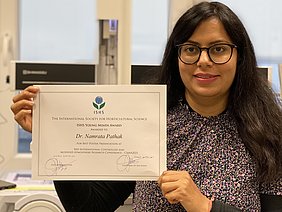At the 13th International Controlled and Modified Atmosphere Research Conference (CAMA2021) ATB scientist Dr.-Ing. Namrata Pathak was awarded with the ISHS Young Minds Award. The conference was held as an online event hosted from Leuven, Belgium on August 16-18, 2021.
Dr.-Ing. Namrata Pathak is researching in the field of quality and safety of food and feed at ATB since 2015. She is member of the working group Packaging and Storage at ATB. For her research on the "Evaluation of ethylene scavengers for potential application in fresh produce packaging" she was now awarded by the International Society for Horticultural Science ISHS with the Young Minds Award for the best poster presentation on occasion of the CAMA2021 conference.
The results she presented are part of the “FreshInPack” project funded by CORNET ("Active Packaging for Fresh Food Market (FreshInPack)". The project aimed at the development of bio-based multifunctional packages with ethylene absorbing and antimicrobial effects for elongating shelf-life of produce.
Most fresh fruit and vegetables are sensitive products with a short shelf-life. Often these are packaged to maintain their quality for a longer time. Active substances can be added in packaging to provide additional benefits such as moisture absorption, removal of foul odour etc. Among such active substances, some materials scavenge or remove ethylene - a colorless gas, often referred to as “ripening hormone”, which is produced by fruit and vegetables. Accumulation of ethylene in packages causes fast ripening in fruit and vegetables, which is often unwanted. Commercial sachets containing such scavengers are usually put in fruit and vegetable packaging to remove ethylene.
In this research work, the main aim was to comparatively analyze various materials developed in-house as well as commercial ethylene scavengers for ethylene removal under similar conditions (temperature 20 °C; humidity ~50 %; and initial ethylene concentration 10 ppm in a 1 L glass jar).
The materials investigated in this study were categorized based on their ethylene removing principle into
- adsorbers (bentonite, sepiolite, halloysite, zeolite, diatomite): these can physically adsorb ethylene, thus, removing it from the environment,
- adsorber-oxidizer (Potassium permanganate (KMnO4) based products, commercial as well as KMnO4 deposited on zeolite in the lab): these chemically react with ethylene, thereby, converting it to other products and these materials are themselves used up in the process irreversibly;
- catalyzers (Titanium dioxide, Magnesium oxide, and diatomite with palladium): these are similar to oxidizers except these remain unused at the end of the reaction.
Natural clays and zeolite did not show any appreciable ethylene absorption. However, a pre-heat treatment of the materials removed attached moisture from the particles resulting in increased ethylene absorption capacity which was enhanced drastically in case of zeolites. KMnO4 based materials showed the best performance in terms of quick removal as well as highest ethylene removal percentage. Titanium dioxide-Palladium showed a very slow rate of ethylene absorption. The results can be helpful in improvisation of scavenging materials.
More information e.g.:
Pathak, N.; Caleb, O.; Rauh, C.; Mahajan, P. (2019): Efficacy of photocatalysis and photolysis systems for the removal of ethylene under different storage conditions. Postharvest Biology and Technology. (January): p. 68-77. Online: https://doi.org/10.1016/j.postharvbio.2018.09.006
Pathak, N.; Rux, G.; Herppich, W.; Rauh, C.; Mahajan, P. (2018): Effect of light wavelength and TiO2 on photocatalytic removal of ethylene under low oxygen and high humidity storage conditions. Acta Horticulturae. (1194): p. 1345-1352. Online: https://doi.org/10.17660/ActaHortic.2018.1194.189

